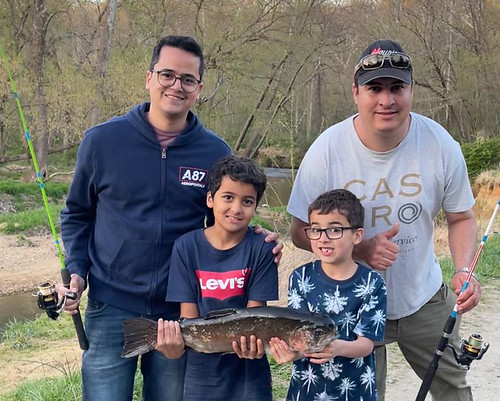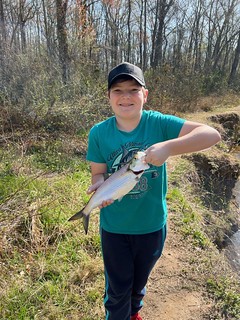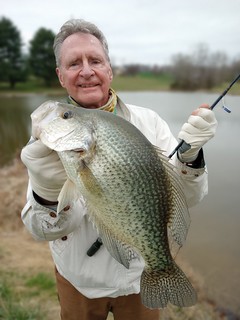
The “Victory Team” of Donizete, Miguel, Lucas, and Benjamin had a great time and formed some lasting memories while trout fishing together. Photo by Donizete Junior
Spring is breaking out all around us, and spending time outdoors with family and friends during this time of year is about as good as it gets.
Forecast Summary: April 12 – April 18:
The beautiful weather will continue through next week and will continue to warm Maryland Bay waters for gamefish including striped bass, shad, and herring which are spawning or preparing to spawn in Maryland waters.
Main Bay surface water temperatures have risen to the middle to upper 50s. River temperatures have also climbed into the middle and upper 50s. Smaller streams and downwind areas on a sunny day will warm faster and often hold water temperatures in the upper 50s to mid 60s.
Expect average clarity for most Maryland portions of the Bay and rivers, however, expect temporarily reduced water clarity from algal blooms on the Gunpowder, Bush, and Back rivers. To see the latest water clarity conditions, check Eyes on the Bay Satellite Maps.
Expect continued below average flows for most Maryland rivers and streams. This may impact the timing and duration of the shad runs. There will be above average tidal currents from Sunday through Tuesday as a result of the upcoming new moon on April 20.
As always, the best fishing areas could be further refined by intersecting them with underwater points, hard bottom, drop-offs, and large schools of baitfish.
For more detailed and up-to-date fishing conditions in your area of the Bay, be sure to check out Eyes on the Bay’s Click Before You Cast.
Upper Chesapeake Bay
[IMG alt="Photo of man and boy at a riverside, holding a huge fish
"]https://live.staticflickr.com/65535/52807504516_6229c86857_w.jpg[/IMG]
Tony and Finn Vachino admire a blue catfish caught near the mouth of the Magothy River. Photo by Patrick Miller
Much of the fishing in the upper Bay is focused on catfish and white perch. There are flathead catfish holding in the Conowingo Dam pool, and they can be caught on heavy surf fishing tackle and casting cut bait into the dam’s turbine wash. Blue catfish can be found in the dam pool, the lower Susquehanna River, and tidal rivers south to the Magothy and Chester rivers. Channel catfish are spread throughout the upper Bay. All can be caught on fresh cut bait, chicken liver, or scented baits.
Hickory shad are increasing in numbers in the lower Susquehanna River near the dam pool and there are reports of a few American shad being caught. Shad darts and small flashy spoons and colorful flies are good lures to use and they are often rigged in tandem. Spawning runs up Deer Creek and Octoraro Creek may occur soon with warmer water temperatures. The first white perch moving into the lower Susquehanna were reported this week, this fishery will gain more speed in the next couple of weeks.
Water temperatures in the Elk River are warm enough this week for striped bass to begin spawning. Striped bass spawning in the lower Susquehanna and Susquehanna Flats will start very soon. Remember that striped bass fishing of any kind is prohibited during this spawning season.
White perch are steadily moving down the tidal rivers in the upper Bay and can be found in middle river sections. Fishing with pieces of bloodworm on a bottom rig in the channel areas is one of the best ways to target them.
Middle Bay

This blue catfish caught recently in the upper Choptank River had two partially digested blueback herring in its stomach. Photo by Keith Lockwood
Fishing for blue catfish is good in the lower Choptank River from the Dover Bridge to the town of Choptank. Channel catfish will also be a large part of the catch. Channel catfish can also be found in the upper Severn, West River, and the Kent Island area. Anglers who have never fished for blue catfish should give it a try. The meat is white and tasty once the silver skin and red meat is removed. Blue catfish populations are exploding in our Chesapeake Bay systems, and they have voracious appetites for everything from blue crabs to sportfish.
White perch can be found in the middle sections of the tidal rivers. The channels are the best place to look for them and casting out a bottom rig baited with pieces of bloodworm is the best way to target them. The post-spawn white perch are making their way down the tidal rivers headed for the summer habitat areas and should arrive at those areas by the beginning of May.
A major striped bass spawn in the middle Bay occurred late last week during a two-day warm spell. Water temperatures rose to 60 degrees and the striped bass did what they came to do. There may be a second major spawn in the next week, but time will tell. Catch-and-release fishing for striped bass in the spawning rivers is illegal due to the stress caused by angling, especially in a mostly freshwater environment where these fish expel excess water and cannot recover well. The Natural Resources Police are patrolling the spawning rivers and anglers can face fines and license suspensions for targeting striped bass during this time.
The fishing piers at Bill Burton Fishing Pier State Park are closed in both Dorchester and Talbot Counties due to structural safety concerns. Shoreline and trail access is open on the Talbot County side of the park and a 270-foot pedestrian access to the Visitor Center boardwalk is open on the Dorchester County side. The piers are the remains of the old Route 50 Bridge built in 1935. Engineers working on the bridge last year determined it to be a safety hazard, leading the Department of Natural Resources to immediately close the deteriorating structure.
Lower Bay

Hickory shad, photo by Eric Packard
In the lower Bay, anglers are focusing their attention on fishing in the tidal rivers. Fishing for blue catfish is always action-packed, there are plenty of them, they are easy to catch, and they provide some excellent eating. The tidal Potomac River channel from the Wilson Bridge to the Route 301 Bridge is full of blue catfish. The Nanticoke River near Sharpstown and the Patuxent River from Benedict to Jug Bay have large populations. Blue catfish are also showing up with increasing numbers in the Wicomico and Pocomoke rivers.
Striped bass began spawning in earnest last week on the Nanticoke River. Targeting striped bass during this time is prohibited.
Post spawn white perch are moving down the Nanticoke River this week and can be found in the river and lower Marshyhope Creek. Pieces of bloodworm on a bottom rig fished in the channels is the best way to target them.
Catch-and-release fishing for hickory shad in the upper tidal Potomac and Mattawoman Creek is good this week. Anglers are enjoying fishing with light tackle and an assortment of shad darts and small flashy spoons, often rigged in tandem. American shad can be found at the Fletchers Landing section of the tidal upper Potomac.
Recreational crabbing officially opened April 1 and it is still very early in the season. There is a change to be noted in the bushel limit per boat with two or more licensed crabbers through June 2023. Visit the Department of Natural Resources website for information.
Freshwater Fishing
Catch-and-release fishing for smallmouth bass is good this week in Deep Creek Lake and the upper Potomac River. A variety of spinnerbaits, Rapala type jerkbaits, tubes, and grubs are all good choices to use. Rocky points and drop-offs are good places to look for smallmouth bass in Deep Creek Lake. In the upper Potomac River, the deeper eddies are good places to target.

Fr. Jim Farmer holds up a nice crappie for a picture. Photo by Tim Campbell
Walleye season is open April 15 in Deep Creek Lake, and size restrictions ease up on the upper Potomac River that day as well. Small Rapala lures are an excellent bait to cast along steep rocky shores in the lake, while tubes, soft plastic jigs, and small crankbaits are good choices when fishing in the deeper areas of the upper Potomac.
Trout season continues stockings taking place in multiple waters all week. April is a great month to fish for trout, especially in some of the marginal areas that become too warm during the summer months. The community ponds that are stocked this time of the year are a wonderful place to introduce children to fishing. Check out our youth fishing website for tips, including where to go and upcoming youth fishing events.
Fishing for largemouth bass is very good as the fish build up body stores before spawning. In many areas such as small ponds and shallow waters that have warmed, males have scooped out spawning beds to attract females. Fishing for largemouth bass is catch-and-release only in non-tidal waters until June 15, and a 15-inch minimum is in place in tidal waters. Most largemouth bass fishing is catch-and-release anyway. The female largemouth bass may be found holding in slightly deeper waters close to the spawning areas or in warmer waters on the spawning beds. A variety of crankbaits, spinnerbaits, jerkbaits, and soft plastics can be good baits for staging largemouth bass. Soft plastic creature baits are often a favorite in the shallow spawning areas.
Springtime water temperatures herald a great time to fish for crappie. They can be found in moderately deeper waters near structure. Fallen treetops, sunken wood, marina docks, and bridge piers all offer places to find crappie holding. Small minnows or marabou jigs under a bobber are a popular way to fish, but casting and slowly retrieving small lures can also work.
Northern snakeheads are becoming more active in many of the tidal waters and a few non-tidal areas this week. Warmer air temperatures and plenty of sunshine are quickly warming up waters. Look for snakeheads on the sunny side of creeks, rivers, and coves holding near shoreline brush. Casting white paddletails is the best way to fish them this time of year, closely followed by drifting large minnows under a bobber.
Atlantic Ocean and Coastal Bays
Anglers fishing on the beaches of Assateague Island and Ocean City are enjoying good fishing for black drum, which can weigh as much as 40 pounds. Clearnose skates are unfortunately chewing up baits, but catching a black drum can make it all worthwhile.
At the Ocean City Inlet and the Route 50 and Route 90 bridges, anglers are having fun catching striped bass. Most of them do not make the 28-inch minimum length but offer plenty of catch-and-release fun on light tackle. Casting soft plastic jigs and working them close to the bottom is a proven tactic. Flounder continue to move through the inlet into the back bays. Water temperatures are still a bit chilly, so an outgoing tide usually offers the best fishing.
Tautog are being caught near the jetty rocks of the inlet, bulkheads, and Route 50 Bridge piers. Sand fleas are the favored bait and the very last of the ebbing tide tends to offer some of the best fishing. There is plenty of action but tautog measuring larger than 16 inches can be hard to find.
The anglers heading out to the offshore wreck and reef sites are not having any trouble catching tautog measuring more than 16 inches. In fact, it is not uncommon for anglers to catch tautog weighing in the double-digit range.
“Poets talk about ‘spots of time,’ but it is really fishermen who experience eternity compressed into a moment. No one can tell what a spot of time is until suddenly the whole world is a fish and the fish is gone. I shall remember that fish forever.” — Norman Maclean
Maryland Fishing Report is written and compiled by Keith Lockwood, fisheries biologist with the Maryland Department of Natural Resources.
Click Before You Cast is written by Tidewater Ecosystem Assessment Director Tom Parham.
This report is now available on your Amazon Echo device — just ask Alexa to “open Maryland Fishing Report.”
